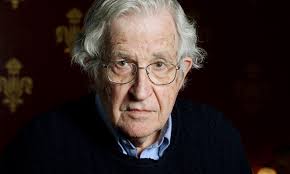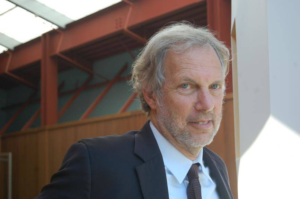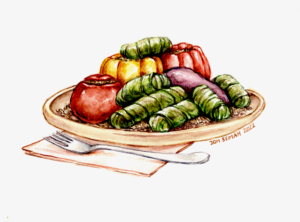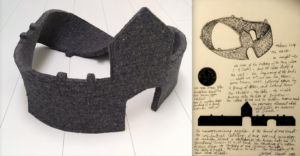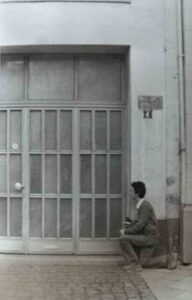Chomsky And Pollin: Protests Outside Of COP26 Offered More Hope Than the Summit
The legacy of the 2021 United Nations Climate Change Conference (COP26) this fall was perhaps best encapsulated by its president, who bowed his head and — close to tears — actually apologized for the process, which ended with a last-minute watering-down of participants’ pledges on coal.
“May I just say to all delegates I apologize for the way this process has unfolded and I am deeply sorry,” said Alok Sharma, the British politician who served as president for COP26. The conference ended on November 13 with a disheartening “compromise” deal on the climate after two weeks of negotiations with diplomats from more than 190 nations.
In the interview that follows, leading public intellectuals Noam Chomsky and Robert Pollin offer their assessments of what transpired at COP26 and share their views about ways to go forward with the fight against the climate crisis. Chomsky — one of the most cited scholars in history and long considered one of the U.S.’s voices of conscience — is Institute Professor Emeritus at the Massachusetts Institute of Technology and currently Laureate Professor of Linguistics and Agnese Nelms Haury Chair in the Agnese Nelms Haury Program in Environment and Social Justice at the University of Arizona. He is joined by one of the world’s leading economists of the left, Robert Pollin, who is Distinguished Professor and co-director of the Political Economy Research Institute at the University of Massachusetts at Amherst. Chomsky and Pollin are co-authors of the recently published book, Climate Crisis and the Global Green New Deal: The Political Economy to Save the Planet.
C.J. Polychroniou: COP26, touted as our “last best hope” to avert a climatic catastrophe, has produced an outcome that was a “compromise,” according to United Nations Secretary General António Guterres, while activists conducted a funeral ceremony at the Glasgow Necropolis to symbolize the failure of the summit. Noam, can you give us your analysis of the COP26 climate agreement?
Noam Chomsky: There were two events at Glasgow: within the stately halls, and in the streets. They may have not been quite at war, but the conflict was sharp. Within, the dominant voice mostly echoed the concerns of the largest contingent, corporate lobbyists; rather like the U.S. Congress, where the impact of lobbyists, always significant, has exploded since the 1970s as the corporate-run neoliberal assault against the general population gained force. The voice within had some nice words but little substance. In the streets, tens of thousands of protesters, mostly young, were desperately calling for real steps to save the world from looming catastrophe.
The outcome of this conflict will determine the course of history — or more precisely, will determine whether future human history will be “nasty, brutish and short” (to lift philosopher Thomas Hobbes’s words) or full of promise and opportunity.
The conflict is nicely encapsulated in a report of Brazil’s National Institute of Space Research. It is dated October 27, just a few days before COP26 opened, offering space for fine words and eloquent promises about saving the Amazon forests, a precious resource for Brazil’s future, and the world’s.
The Institute reported that “the area deforested in Brazil’s Amazon reached a 15-year high after a 22% jump from the prior year, [an outcome that] flies in the face of [the Jair] Bolsonaro government’s recent attempts to shore up its environmental credibility,” to put it politely.
It was put less politely by spokespersons for Brazilian and international environmental organizations. One said, “We are seeing the Amazon rainforest being destroyed by a government which made environmental destruction its public policy.” Another said: “This is the real Brazil that the Bolsonaro government tries to hide with fantastical speeches and actions of greenwashing abroad. The reality shows that the Bolsonaro government accelerated the path of Amazon destruction.”
Within the halls there were many “fantastical speeches,” while the outside world revealed much that “flies in their face.” Within, there was great enthusiasm about the $130 trillion that will be provided by financial institutions to rescue us. U.S. chief negotiator John Kerry was exultant that the market is now on our side.
He might be right, if we understand the phrase “the market” to refer not to the “fantastical” concept that is conjured up in public discourse but to the real world market: What Robert Pollin and Gerald Epstein call the neoliberal “bailout economy.”
How the holy market works in this case is outlined by political economist Adam Tooze. Lending by the holders of the rescue package of $130 trillion “will not be concessional,” he writes.
“The trillions, Kerry insisted to his Glasgow audience, will earn a proper rate of return. But how then will they flow to low-income countries? After all, if there was a decent chance of making profit by wiring west Africa for solar power, the trillions would already be at work. For that, Larry Fink of BlackRock, the world’s largest fund manager, has a ready answer. He can direct trillions towards the energy transition in low-income countries, if the International Monetary Fund and the World Bank are there to ‘derisk’ the lending, by absorbing the first loss on projects in Africa, Latin America and Asia. Even more money will flow if there is a carbon price that gives clean energy a competitive advantage.”
“It is a neat solution,” Tooze adds: “The same neat neoliberal solution that has been proffered repeatedly since the 1990s. The same solution that has not been delivered.” And won’t be delivered unless the friendly taxpayers (excluding the rich, who are granted ways to exempt themselves) perform their neoliberal duty in the “bailout economy.”
Others added their own interpretation of the lofty rhetoric within the halls. Not least Washington. “We must seize this moment,” President Joe Biden declared in Glasgow. On returning home, he “opened the largest oil and gas lease sale in U.S. history,” carrying out a program set in motion by former President Donald Trump.
The Art Of Cooking – Iraqi Dolma
Dolma is no doubt a classic middle eastern dish – yet every country has its own version.
It is basically stuffed vegetables with a filling of rice and meat mixture!
Although the Greek version might be the most recognized version – the Iraqi dolma has unique sweet and savoury flavours!
Ingredients:
Small paprikas any color
Small eggplants
2-3 Large hard tomatoes
Grape leaves
2 Large onions
A couple of potatoes
500 gram Basmati rice
300 gram Ground beef or lamb
A nice large can of tomato paste
4 cloves of Garlic
Olive oil
Fresh parsley
Pomegranate Molasses or Syrup
500 ml of vegetable or beef stock
Salt
Pepper
Cumin powder
Paprika powder
Coriander powder
1 Lemon
How to prepare the vegetables:
So first we are going to prepare the vegetables -to be stuffed later on.
First, cut the heads of the eggplants and remove the insides (Do not throw the insides away.)
Cut open the top of the tomatoes and scoop out the inside seeds (Do not throw the inside away.)
Peel the onions, cut open on one side, and separate all the layers, then boil some water and simmer the onion layers and the grape leaves for about 2 minutes and remove.
Cut the stems off the grape leaves and the softer edges to form the grape leaves into sheets.
How to make the stuffing of the vegetables:
Place the washed rice in a large bowl, the ground meat, the insides of the tomatoes, and the eggplants. Finely slice some garlic as well as parsley and add to the bowl!
Add half a cup of pomegranate molasses, squeeze some lemon juice, and a couple of tablespoons of olive oil into the bowl.
Continue adding a tablespoon of cumin, paprika, coriander powder, 2 tablespoons of salt, and some black pepper depending on preference.
Make sure to mix well and then your stuffing is ready!
Let’s stuff the tomatoes, the eggplant, and the paprika – it should be an easy task – simply stuff the vegetables and close the top like a lid.
Next, the stuffing of the onions is a bit tricky. Place a bit of stuffing on 1 side of the onion layer and roll it to resemble a dumpling shape, if the onion layer is not big enough, you can always add another layer of onion over the first one.
Now the grape leaves, place them flat like a piece of paper or like a sushi roll, and make sure the veiny side is pointing up. Place some stuffing in the middle of the leave towards you, fold the sides onto the stuffing and roll it to close it tightly!
Cooking the dolma:
Cut the potatoes into large slices and place them in the bottom of a big pot (this will prevent the vegetables from sticking, and by that to make them super tasty).
Now, stack the stuffed vegetables, the stuffed grape leaves, and the stuffed onion on top of the potatoes in any way you like – if you have any leftover stuffing, you can make small meatballs and add them as well to the pot.
Add a bit of olive oil and cook on medium heat for 15 minutes with the lid on, while cooking you can prepare the juice to add.
In a bowl mix the stock with a large tablespoon of tomato paste, pomegranate molasses, some lemon juice, add some salt and pepper, and mix until dissolved.
When the 15 minutes are over, remove the lid and gently pour the liquid into the pot until covered and place the lid back on, and then turn the heat down low.
Cook for 40 minutes, and when done let it rest for 10 to 20 minutes.
Traditionally the food should be flipped onto a big plate; if you choose this way, make sure to do it with confidence!
This dolma dish is definitely the star of the show, for some serving tips I recommend eating it with fresh salad, and maybe bread, and some dipping sauces.
Enjoy!
Climate Diplomacy Failed Again. Only Movements From Below Can Save The Planet
The outcome at COP26 doesn’t bode well for the future of the planet, but then again, no one remotely aware of the history of international climate talks should have expected anything but a failure at Glasgow.
As a matter of fact, given what we already know about the science of climate change (fossil fuels are the primary culprits behind global warming), and, in light of our experience with the catastrophic effects of global warming (heat waves, wildfires, floods, droughts, melting glaciers, rising sea levels, habitat loss and species extinction), COP26 must be regarded as a “monumental failure.”
Indeed, it is quite shocking to see reports and commentaries from certain quarters trying to convince the public that COP26 represents a step forward in the fight against the climate crisis.
Why? Because for the first time in nearly three decades the world “coal” was used in a COP climate agreement? Or because of the pledge to end deforestation by 2030? Or could it be because world leaders agreed to end “inefficient” subsidies for fossil fuels?
Hypocrisy reigned supreme at COP26 in Glasgow. Leaving aside the presence of the fossil fuel industry with a bigger delegation than any country, most world leaders were there to defend their national economic interests rather than the sustainability of the planet.
Let’s start with President Joe Biden. He argued that “there is no more time to hang back or sit on the fence,” and then sought to convince everyone present that the U.S. will “lead by example” in the fight against global warming. How? By leasing over 80 million acres of public waters in the Gulf of Mexico to fossil fuel companies for oil and gas extraction immediately after his rhetorical posture at COP26.
And let’s not forget his urgent plea to OPEC just a few months ago to increase oil production.
Perfect samples of leading by example!
How about Australia, whose current government vows to keep using and selling coal for decades to come?
Countries such as China, Russia, Brazil, Saudi Arabia, to name just a few, worked hard during the negotiations to weaken as much as possible the final COP26 pact.
Of course, wealthy nations, which are primarily responsible for the climate crisis, bear the vast majority of the blame for climate impasse.
Their failure to honor a pledge of $100 billion in climate financing a year to poor nations, which are hit hardest by the consequences of global warming, speaks volumes of their commitment to the transformation of a sustainable and just future. So does their position on the issue of financing for “losses and damages” at COP26, which was deliberately couched in very vague terms and was left to be addressed in future climate talks.
But that’s what international climate diplomacy amounts to in the end: governments fighting for a climate agenda that won’t harm the specific interests and needs of their own ruling classes. This is exactly the reason why world leaders have been kicking the can down the road for nearly three decades now when it comes to taking drastic measures to combat global warming.
The truth of the matter is that whatever progress has been made so far in our fight against the climate crisis has been greatly due to activism on the part of individuals and a wide array of organizations such as community groups, labor unions, non-governmental organizations, and Indigenous groups. Youth voices on the climate crisis have been, of course, most instrumental in raising public consciousness and building momentum for the formation of a global climate movement, which is our only hope left towards securing the goal of sustainability for all life on Earth.
The irony is that actually no sober and rational thinking human being could possibly have any illusions about the challenge humanity faces in the 21st century. It requires an indubitably high level of ignorance, in conjunction with a heavy dose of misanthropy, to pass over the fact that the world is faced with a titanic struggle over how to save the planet.
Moreover, there is no mystery about how humanity can avoid a possible collapse of civilized order as we have known it. A global Green New Deal is our only hope to save the planet from the disastrous effects of global warming caused by the burning of fossil fuels. Decarbonization in conjunction with natural climate solutions such as reforestation are key to making sure that humanity doesn’t get trapped in a conundrum the “the gates of hell are locked on the inside.”
There is no other choice at the present juncture. It is still not clear to what degree technology can be part of the solution at some point in the future, and we surely have no luxury in waiting to find out whether emerging technologies can solve the climate crisis.
Also, let’s have no illusions about the global Green New Deal project. This is not some sort of a utopian dream, as its opponents seem to suggest. The research, for instance, conducted by economists at the renowned Political Economy Research Institute (PERI) of the University of Massachusetts-Amherst shows with unquestionable clarity that the implementation of the Green New Deal project will not only spare us from the worsening effects of global warming, but will also ensure sustainable development and a just transition.
But, perhaps more important, there are already scores of organizations in places all over the world working hard to turn the Green New Deal vision into reality. For example, ReImagine Appalachia, a collection of individuals and organizations seeking to “built a sustainable 21st century Appalachia,” is restoring damaged lands and water, refashioning the electric grid, building a sustainable transportation system, reforesting the region, while at the same time promoting union rights and ensuring that workers in extractive industries remain vital elements of the workforce in the post-fossil fuel economy.
Mass organizing is central, of course, to the attainment of the goals set forth by Reimagine Appalachia. Amanda Woodrum, Senior Researcher, Policy Matters Ohio, and Co-Director, Project to ReImagine Appalachia, says ReImagine Appalachia “reaches out and engages a wide variety of stakeholders – labor, faith, enviro, racial justice, criminal justice reform advocates, local electeds and others.”
Indeed, participation from below is the key to ensuring a societal transformation towards sustainability. As Amanda Woodrum so eloquently expressed to Truthout, this is the only way that “Appalachia stays on the climate table, otherwise it will be on the menu.”
In addition, ReImagine Appalachia appears to have developed a very effective local elected outreach strategy, which, according to Amanda Woodrum, “has secured a number of endorsements from local electeds and passed community resolutions in several communities.” Equally important, the organization has launched BLAC, the Black Appalachian Coalition, an initiative led by Black women, as Black Appalachians have been hit hardest by the downward mobility of the neoliberal project since the 1980s.
The outcomes of international climate summits are very discouraging, but the work done at the grassroots level by researchers and activists alike in the fight against humanity’s greatest existential crisis is quite inspiring.
So, yes, the struggle ahead promises to be hard and brutal, but the “general will” can always prevail in the end even under the most gruesome of circumstances if people are willing to fight for the right cause. And no cause can be more sacred than saving planet Earth.
C.J. Polychroniou is a political scientist/political economist, author, and journalist who has taught and worked in numerous universities and research centers in Europe and the United States. Currently, his main research interests are in U.S. politics and the political economy of the United States, European economic integration, globalization, climate change and environmental economics, and the deconstruction of neoliberalism’s politico-economic project. He is a regular contributor to Truthout as well as a member of Truthout’s Public Intellectual Project. He has published scores of books and over 1,000 articles which have appeared in a variety of journals, magazines, newspapers and popular news websites. Many of his publications have been translated into a multitude of different languages, including Arabic, Chinese, Croatian, Dutch, French, German, Greek, Italian, Japanese, Portuguese, Russian, Spanish and Turkish. His latest books are Optimism Over Despair: Noam Chomsky On Capitalism, Empire, and Social Change (2017); Climate Crisis and the Global Green New Deal: The Political Economy of Saving the Planet (with Noam Chomsky and Robert Pollin as primary authors, 2020); The Precipice: Neoliberalism, the Pandemic, and the Urgent Need for Radical Change (an anthology of interviews with Noam Chomsky, 2021); and Economics and the Left: Interviews with Progressive Economists (2021).
Activism, Not Global Climate Summits, Is The Answer To The Climate Crisis
In response to COP26, C. J. Polychroniou argues that we cannot rely on summits to solve climate change. Instead, radical and legal activism are the best hopes for our future.
The outcome of international climate summits hasn’t changed over the last few decades. The task of forging a global consensus on transformative mitigation strategies to the climate emergency somehow always eludes the participating parties, and the result is to keep kicking the can down the road as if to say, “let future generations take care of the problem.”
Unfortunately, in spite of being touted as “our last best hope,” the COP26 climate summit in Glasgow ended up being just another big flop, thus confirming the position of Democratic US Rep Alexandria Ocasio-Cortez that people shouldn’t expect international climate summits like COP26 or governments to solve the climate crisis.
Indeed, the only hope for solving humanity’s greatest existential crisis lies with our ability to mobilize people behind the global climate movement.
The outcome of COP26, a great “compromise” between moderates and reactionaries, does very little to slow the pace to the precipice. The final document, called the Glasgow Climate Pact cma3_auv_2_cover decision (unfccc.int), made no progress with regard to existing national plans to cut emissions by 2030, which are highly inadequate to limit warming to 1.5C. In fact, as things stand, the planet is headed to a disastrous 2.4C of heating. And only very naïve souls can gain comfort from the fact that the pact obliges countries to return to next year’s COP with revised targets.
Fossil fuels, which supplied 84 percent of global energy in 2020 Fossil Fuels Still Supply 84 Percent Of World Energy — And Other Eye Openers From BP’s Annual Review (forbes.com), will continue to dominate global energy consumption. The power of the fossil fuel producers is apparently too strong to counter in diplomatic negotiations over the future of the planet.
Moreover, nothing was done in relation to the issue of climate finance, and rich countries have failed to honor their pledge of providing $100 billion each year by 2020 to help the poor nations deal with the threats of global warming. In the meantime of course, climate debt grows exponentially.
In sum, decarbonization remains a distant dream in spite of the pressing need to do so almost immediately in order to keep temperatures from rising “well above 2C.” At COP26, amazingly enough, even coal, the dirtiest of the fossil fuels and the single largest source of global temperature increases, received a mere slap in the hand as India, with the backing of China, succeeded in changing the wording of an earlier draft from “phase out” coal to “phase down.”
All this while there is a near unanimous consensus among scientists that global warming is caused from human-produced greenhouse gas emissions and that the climate crisis represents humanity’s largest existential crisis.
If COP26 participants were really serious about solving the climate crisis they should have made, at a minimum, the following pledges:
- Eliminate all fossil fuel subsidies, which according to a recent IMF study amounts to $5.9 trillion in 2020;
- Ban banks from funding new fossil fuel projects;
- Make ecocide an international crime similar to genocide, crimes against humanity, and war crimes;
- Demand the cancellation of debt for lower income countries, which now spend several times more on servicing debt than dealing with the challenges of global warming;
- Create large-scale funding sources to assist with the transition to a green economy.
Instead, we got mostly a lot of “blah, blah, blah” and more inertia.
But why the persistent failure among governments in putting the world on a sustainable climate pathway?
Yes, the existential crisis of global warming must be addressed in a world occupied by mainly egoistic and highly imperfect creatures; where the nation-state remains the primary political unit; and with an economic system in place that is driven by the maximization of profit and the exploitation of natural resources. Under neoliberalism, in particular, nature is being destroyed at unprecedented levels, while “the average global temperatures have risen relentlessly.”
But, alas, it’s not all so difficult or hopeless as the international climate summits make it seem. We have made some progress in the fight against global warming. Cities worldwide are at the forefront of climate action, thanks to grassroots activism. The majority of European cities have already committed themselves to reaching carbon neutrality by 2050, with 12 of them before 2040. In California, a project of building a clean energy infrastructure and reducing emissions by 50 percent as of 2030 and achieving a zero-emissions economy by 2045 has been endorsed by nearly 20 major unions across the state. In the Ohio River Valley, ReImagine Appalachia, a broad coalition of individuals and organizations, is laying the groundwork for a post-fossil fuel economy.
Activism is indeed the key ingredient behind the support for green transition programs, and even some major legal victories have been won in the fight against global warming. European courts sided with activists in their effort to put an end to logging in an ancient protected forest in Poland, driving bans have been enforced in some of Germany’s inner cities, and a Dutch court ordered oil giant Royal Dutch Shell to cut its greenhouse emissions by 45 percent by 2045.
Thanks to activism, judges refuse to leave issues about climate and the environment totally in the hands of policymakers.
This is a trend that will most likely increase in the years ahead as international climate summits and governments fail to take the drastic measures needed to for the planet to avoid a climate catastrophe.
As such, revolutionary activism is indeed our last best hope to keep humanity from returning to barbarism on account of the potential collapse of civilized social order due to a climate apocalypse.
In practice, this means turning every city and every town in every major country around the world into a stronghold of the global climate movement. This is the only way that the “general will” can be enforced on the powers-that-be.
Source: https://www.globalpolicyjournal.com/activism-not-global-climate-summits-answer-climate-crisis
C.J. Polychroniou is a political scientist/political economist, author, and journalist who has taught and worked in numerous universities and research centers in Europe and the United States. Currently, his main research interests are in U.S. politics and the political economy of the United States, European economic integration, globalization, climate change and environmental economics, and the deconstruction of neoliberalism’s politico-economic project. He is a columnist for Global Policy Journal and a regular contributor to Truthout as well as a member of Truthout’s Public Intellectual Project.
On Friendship / (Collateral Damage) IV – A Critical Project On Post-War Artist Joseph Beuys
 On Friendship / (Collateral Damage) IV – How to Explain Hare Hunting to a Dead German Artist [The usefulness of continuous measurement of the distance between Nostalgia and Melancholia] (September 2021 – June 2022)
On Friendship / (Collateral Damage) IV – How to Explain Hare Hunting to a Dead German Artist [The usefulness of continuous measurement of the distance between Nostalgia and Melancholia] (September 2021 – June 2022)
A critical project concerning post-war artist Joseph Beuys
Created by Joseph Sassoon Semah, curator Linda Bouws
© Stichting Metropool Internationale Kunstprojecten
Introduction
In 2021/22 the 100th anniversary of the birth of artist Joseph Beuys will be celebrated in Europe, among others with the special event ‘Beuys 2021. 100 years’. Twelve cities and twenty institutes in Noordrijn Westfalen in Germany will be organizing exhibitions, theatre and other activities to celebrate this anniversary. (see for more info https://beuys2021.de/en).
Joseph Heinrich Beuys (1921, Krefeld- 1986, Dusseldorf) is one of the most influential German post-war artists, who became particularly famous for his performances, installations, lectures and Fluxus concerts. But who was Beuys truly? Joseph Beuys mythologized his war history as a National Socialist and Germany’s problematic and post-traumatic past. After Word War ll Beuys transformed himself from perpetrator to victim. His service in the Luftwaffe did not offset his artistic practice. During this 100-years event none of these controversial aspects of Beuys’ work, values and ideas are focused upon. As part of this celebration it is high time to add a more critical eye on Beuys’ work and his relationship to Germany’s post-war history.
Project
On Friendship / (Collateral Damage) IV -How to Explain Hare Hunting to a Dead German Artist [The usefulness of continuous measurement of the distance between Nostalgia and Melancholia] (‘Hasenjagd’ is the code word for killing Jews during World War II) centers on Joseph Beuys and Joseph Sassoon Semah takes us on a journey of critical analysis of Beuys. Linda Bouws is the curator.
Art cannot be seen disengaged from society – which political, social and cultural implications does Joseph Beuys’ work show us?
How do work and politics relate in Beuys’ work, what is myth and what is reality? Did Beuys free art of power and financial gain or did he use his art with the purpose to forget or idealize his own war history and that of Germany? Does his transformation from perpetrator to victim fit into post-war Germany? How did Beuys use his ‘visual codes’, that have disappeared, and secret symbols? How must we interpret Beuys in this celebratory year 2021?
Joseph Sassoon Semah, has done extensive research into Joseph Beuys’ work, values and ideas and based on this research and texts he will analyse the deeper meaning of the (secret) symbols used by Joseph Beuys for ‘On Friendship / (Collateral Damage) IV- How to Explain Hare Hunting to a Dead German Artist [The usefulness of continuous measurement of the distance between Nostalgia and Melancholia]’. He will react to them using new monumental sculptures and a series of old and new drawings, performances, texts and meetings.
This project wants to raise public awareness about the missing information on Joseph Beuys. Information that has been disregarded during this celebratory year or has been evaded to avoid uncomfortable confrontations.
A new project about the reading of Beuys’ ‘shrouded’ art by the Jewish-Babylonian artist Joseph Sassoon Semah.
We will cooperate with among others with Gerard-Marcks-Haus Bremen, Goethe- Institut Amsterdam, Duitsland Instituut Amsterdam, Lumen Travo Gallery, Redstone Natuursteen & Projects, the Jewish Historical Museum and The Maastricht Institute for the Arts. After completion of the manifestation a complementary publication will be compiled.
Metropool International Art Projects
Contact: Linda Bouws
lindabouws@gmail.com
Mob +31(0) 620132195
The project is realised in part with the support of The Mondriaan Fund, the public fund for visual art and cultural heritage and Redstone Natuursteen & Projecten
Mati Shemoelof – Opening Words – On Friendship / (Collateral Damage) IV, October 28, 2021, Goethe-Institut Amsterdam, Performance
28 October 2021, 20.00 pm, Performance and Meeting – Mati Shemoelof (Poet, Author, Editor, Journalist, Berlin) & Joseph Sassoon Semah
The discussion about the creative activities of Joseph Beuys adhere to Eurocentric culture in general and to post-war German culture in particular. And yet, what will happen when two Iraqi Jews, i.e. Babylonian Jews – who live in two European capitals, Berlin and Amsterdam, respectively – decided to deconstruct Beuys’ post war art production.
Could we give these two guests who became our host free speech, and should we listen to their desire to reclaim the Jewish Babylonian tradition from Joseph Beuys’ art?
Most of the research on Joseph Beuys artistic activity has been generated by theories concerning Eurocentric culture, values and experiences, however this time we have the opportunity to hear other voices, a different reading that criticizes Beuys’ work.
Mati Shemoelof – Opening Words 28.10.2021. Goethe Institut – Amsterdam
Joseph Sassoon Semah’s artistic work criticizes and unmasks the work of Joseph Beuys, the most influential German artist post WWII. In his criticism of Beuys’ art, Joseph Sassoon Semah uses the term “An Oppressive memory”. To my mind, he means how an oppressor performs/re-presents/re-disguises himself as a victim and by doing so, he silences the victim.
Beuys, the big shaman of German art, spoke of the famous LEGEND of how his airplane was shot down and that he was saved by the Tartars. This is a myth that he created in order to make us feel compassion for his deeds.
Let us first state the facts: In 1936 Beuys was a member of the Hitler Youth. We know that it was compulsory, but later on, in 1941, Beuys volunteered for the Luftwaffe (the aerial warfare branch of the Wehrmacht during World War II). In 1942, Beuys was stationed in Crimea and was a member of various combat bomber units. From 1943 on he was deployed as a rear-gunner in the Ju 87 “Stuka” dive-bomber. Initially stationed in Königgrätz, later on in the eastern Adriatic region. On March 16th 1944, Beuys’ plane crashed on the Crimean Front, close to Znamienka. Records state that Beuys was conscious and recovered by German search commandos. There were no Tatars in the village at that time however. Beuys was then brought to a military hospital where he stayed for three weeks from March 17th to April 7th.
The research, texts, performances, art works and installations of Joseph Sassoon Semah today is a Babylonian Jewish de-construction of the artistic activities of Beuys from the center of Europe. In his artistic performance Joseph Sassoon Semah refers to two famous installations of Beuys. The first is the “Straßenbahnhaltestelle / Tram Stop” that was unveiled at the Venice Biennale of 1976. Joseph Beuys created a copy of a monument which was placed next to Tram Stop in Kleve – consisting of a field cannon crowned with a bust based on the figure of “Jean Baptiste Cloots”. Cloots was born in 1755 near Kleve, at the castle of Gnadenthal, and later called himself “Anachrsis Cloots”. He later joined the French revolution and symbolizes democracy.
Joseph Beuys’ Tram Stop in 1976 is in a matter of fact a memory of Beuys as a 5 year old kid waiting for the train that would take him to visit his uncle who lived in Kleve. Joseph Beuys explained that he used to cross the street and sit on the monument named by the city as the “Iron Man”; At a certain time, the field cannon was crowned with a cupid. So, the memory is love and the idea that democracy should be spread by the cannon, and not war.
In Kleve not so far from the tram stop, there was a Jewish synagogue that was destroyed by Nazi troops during Kristallnacht. And when you add the fact that Beuys himself was part of the Nazi air force you get a story of re-creating himself as a rebel figure. Meanwhile ignoring the authentic victim while re-presenting himself as a victim.
Joseph Sassoon Semah doesn’t forget Kleve’s synagogue, as well as the real actions of Beuys. He writes letters to Albrecht Dürer, another German artist, in order to penetrate the German and European cannon and to bring back the lost Jewish voice. He writes: “All in all, Jose[f]ph Beuys’ Straßenbahnhaltestelle / Tram Stop 1976 is physical – that is a real visible object in opposition – a manifestation to be contemplated from afar. The result of the intolerable conflict of false and true elements in Jose[f]ph Beuys’ ideology which he tried to expand – to escape as it were, from his impossibility, i.e. from his post-traumatic stress disorder into a symbolic Healer of post-war West Germany, and at the same time to foster its future reputation.”
In another famous Artwork Beuys planted 7000 Oak trees throughout the city of Kassel – each tree accompanied with basalt stone – as part of the seventh Documenta in Kassel (1982). Joseph Beuys’ idea was to breath life back into the emptiness and rubble of 7000 bomb holes that were left bythe carpet bombing made by the allies in WW2.
Joseph Sassoon Semah refers to different theological resources – the Bible and the New Testament – in order to find the origins of meanings of the number 7000.
1 Kings: 19: 17-18 “17. And it shall come to pass, that him that escapeth the sword of Hazael shall Jehu slay: and him that escapeth from the sword of Jehu shall Elisha slay. 18. Yet I have left me 7000 seven thousand in Israel, all the knees which have not bowed unto Baal, and every mouth which hath not kissed him.”
And the New Testament – Romans 11:4 – “But what saith the answer of God unto him? I have reserved to myself 7000 seven thousand men, who have not bowed the knee to the image of Baal.”
Joseph Sassoon Semah uses these two resources in order to re-capture the real essence of the number 7000. He also uses an additional theological resource to capture the essence of The OAK and the Stone from the Old Testament – The Bible tells us about the OAK AND THE STONE – Joshua 24 :25-27: “On that day Joshua made a covenant for the people, and there at Shechem he established for them a statute and ordinance. recorded these things in the Book of the Law of God. Then he took a large stone and set it up there under the oak that was near the sanctuary of the LORD. And Joshua said to all the people, “You see this stone. It will be a witness against us, for it has heard all the words the LORD has spoken. To us, and it will be a witness against you if you ever deny your God.”
To summarize my ideas until now, I want to contextualize why we are doing the action of planting an OAK tree and placing it next to a Stone originated from Jerusalem. Joseph Sassoon Semah wants to create a real new covenant with God. Not the God of the scripture, but the spiritual one. He reclaims the Jewish symbols which Beuys appropriated, and recreates a new symbolic order on the land of Europe. It is both an artistic moment and a spiritual one, both happening here on the European ground.
Beuys refers to Kleve with nostalgia and at the same time forgets about the Kristallnacht and his own involvement in WW2; Beuys also refers to the bombing of KASEL and forgets that it took place in order to defeat NAZI troops and to stop the destruction of Jewish life. In his position Beuys appropriates the victim voice but Joseph Sassoon Semah reclaims it and re-creates a new alliance with God using the old meaning of the Oak tree and the stone here in the garden of Goethe Institute.
2.
Joseph Sassoon Semah’s de-construction of Beuys art is also another dialogue that he conducts as an Israeli Jew who emigrated to Europe.
In his artistic performances and installations, he criticizes the admiration of Israeli artists toward Beuys.
In his insightful article, Dr. Kobi ben Meir writes about “Joseph Beuys and the Cultural Effect of Israeli Art of the 1970s”. I will use some of his ideas in order to reflect upon Joseph Sassoon Semah’s sharp artistic and poetic response to the Israeli admiration of Beuys’ art.
At the art school of Bezalel, Beuys became a revered hero, and Israeli artists made a pilgrimage to his Studio in Düsseldorf. The known Israeli artist David Ginaton says that he first heard about the beginning of the Yom Kippur War as he was he travelling by train to Düsseldorf. As soon as they arrived in Düsseldorf on the second day of the war, on October 7th, 1973, Ginaton went to Joseph Beuys’ home. After ringing the doorbell of Beuys’ house, his wife opened the door and said that her husband was out of town for several days. Ginaton’s partner photographed him kneeling in front of the door of the Beuys’ house.
It is interesting to examine how Ginaton positions himself in front of the closed door of Beuys’ house. When it comes to size ratios, the young artist appears small in size and is almost disappearing in front of the massively large door. He kneels like an admirer of a holly person, and while he lowers himself, he is looking up as if at a holy past or a coveted hero. Ginaton kneels outside the door frame in a sense the frame represents the high German art world to which he can’t enter. Therefore, Ginaton has no choice but to admire in reverence. Dr. Kobi ben Meir concludes that this admiration is a sign of pagan fetishism.
If we go back to the first part of my interpretation of the artistic work of Joseph Sassoon Semah, we will find the real man behind Beuys. The soldier, the oppressor who manipulates through his myth in order to transform himself into the voice of the oppressed. When we observe the kneeling of Ginaton in frontof Beuys door – We get a distorted image.
How is it possible then that the Israeli Jewish artists, most of them second-generation Ashkenazi Jewish Holocaust survivors – are kneeling in front of Joseph Beuys and not the other way around?
Only 30 years after 1945 Beuys transformed himself into an extraordinary identity, which somehow forced them to forget about his real past actions.
David Ginaton testifies that through this photo and others he sought to clarify the relationship between Israeli art and international art, and to discuss questions of influence and appropriation.
In this photograph, the Israeli artist reveals himself as inferior to European art as part of a central and peripheral relationship, both influential and influenced.
In his artistic works Joseph Sassoon Semah removes the veil and de-mystifies this distorted identity. Joseph Sassoon Semah is both a European/Amsterdam Based artist and a post-Israeli one. In having this dual identity he raises critical questions directed at the backbone of German and European art (Dürer-Beuys) and at the same time directs his artistic critical gaze towards the Israeli Jewish field of art to which he belonged before leaving Israel. He questions the reasons for the admiration that borders on self-cancellation.
There are several answers I can give as a commentator concerning these distorted relationships of the Israeli art world towards the image of Joseph Beuys:
1. The Israeli militarism, subconsciously is being connected to the figure of the German soldier, in which the Israeli admiration towards the Israeli soldiers is evident.
2. The insult felt by the survivors of European descent from Europe. Yes, the same Europe that annihilated their families, became a phantasmatic desire to be accepted by them.
3. There is an element of an imagined return to the ethnic hierarchies that existed before World War II, in which European Germans were above all and Asians were inferior. That is, in perverted peripheral/center relations that recur in the minds of the Ginaton as a symptom to the positioning of the Israeli art in relation to the European art.
You can read it well in the famous Hannah Arendt‘s quote in a letter she wrote from Jerusalem in 1961, when she was attending the Eichmann trial. Her description of the crowd at the courthouse, in a letter she sent to Jaspers, passes beyond condescension into outright racism: “On top, the judges, the best of German Jewry. Below them, the prosecuting attorneys, Galicians, but still Europeans. Everything is organized by a police force that gives me the creeps, speaks only Hebrew, and looks Arabic. Some downright brutal types among them. They would obey any order. And outside the doors, the oriental mob, as if one were in Istanbul or some other half-Asiatic country.”
Joseph Sassoon Semah’s gaze is a DOUBLE gaze, it resembles the double face of Janus the god of Gates: On the one hand, he deconstructs and demystify the admiration of the Israeli artist to Joseph Beuys. On the other hand, his artistic work criticizing and unmasking the work of Joseph Beuys and the whole European cannon.
He also uses old Biblical knowledge (don’t forget that he is the grandson of the last Rabbi of Bagdad). So, his art is also a living traditional performance that is very much inspired by the Jewish tradition in order to re-present and re-perform a new artistic, social and political, spiritual and geographical order between his Babylonian Jewish point of view and his temporary place /HaMakom – both towards the German European art and the Israeli art.
